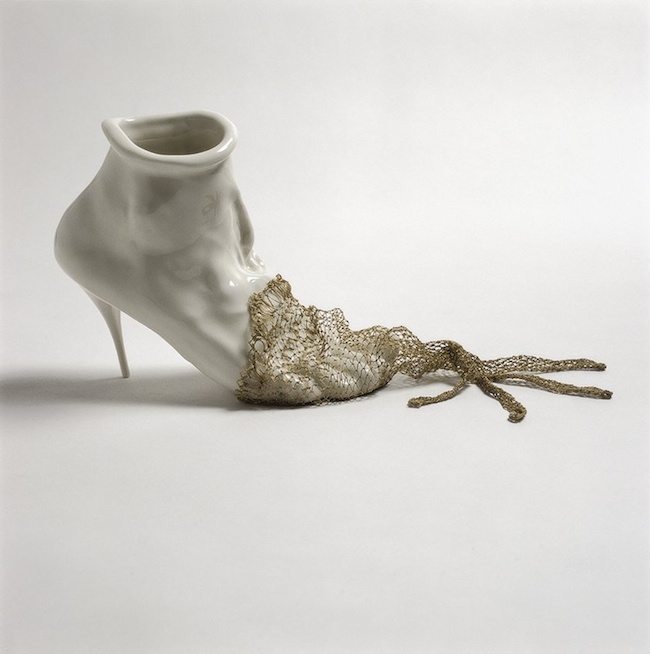Birgit Jürgenssen (b. Vienna, Austria, 1949; died Vienna, Austria, 2003) was an artist whose work combined two things that are close to my heart: surrealism and irony. They paired well with her feminist politics, as you will soon see in the collection of images we’ve assembled today.
Above image: Birgit Jürgenssen, Porcelain Shoe (Model B.K.), 1976; porcelain, crochet and yarn; 5 7/8 x 13 x 4 inches. Photograph courtesy of Alison Jacques Gallery and the artist’s estate.
Humor is a useful tool to attack dominant power structures, exposing them as absurdities by carrying them to their warped conclusions. Surrealism buttresses that in Jürgenssen’s work. Her shoes look like they were designed by a computer, or another species that has studied human fashion and society for a few months. This designer is trying its best, but it’s emphasizing all the wrong things. Its designs are certainly honest, and since the designer is a few paces removed from us, it can show us truthful features of our culture that we’re blind to because we’re too close to them. We have no choice but to accept its readings as valid, strange as they are.

Birgit Jürgenssen, Pregnancy Shoe, 1976; leather, wood, tull and lace; 9 7/8 x 4 x 7 inches. Click to see a larger image.

Birgit Jürgenssen, Bed Shoes, 1976; wood, brass, and fabric; 9 7/8 x 4 3/4 x 3 1/8 inches. Click to see a larger image.
Daniele Perra, writing for Unflop Magazine in 2014, interviewed Hubert Winter, her gallerist in Vienna. Thanks to the sometimes glacial speed of recognition in the art world, Jürgenssen is just now experiencing a comeback. Perra asked Winter about the irony I mentioned earlier. I think Jürgenssen’s use of the word is slightly different from our understanding, or at least different in its intended effect. For Jürgenssen irony wasn’t directed at an outside target, like one would use satire on an outside target. Irony was directed at herself, a tool used to remove the artist a few paces away from the rest of us and give her a clearer perspective. You could think of it as a journalistic irony. She called it “self-irony,” saying, “For me, self-irony is a kind of autobiographic strategy, making it easier to convey the potential for subversion and deconstruction.”

Birgit Jürgenssen, Chou-Chou Model, 1972; pencil, colored pencil on handmade paper; 12 1/4 x 17 3/8 inches unframed. Click to see a larger image.
Winter credited Jürgenssen’s rediscovery with the work of her estate, in collaboration with the Alison Jacques Gallery in London and McCaffrey Fine Arts. McCaffrey’s St. Barth gallery is currently exhibiting her through March 26. An artist who worked across mediums, Jürgenssen attracted the attention of people in the fashion world. The same shoes that took swipes at the industry were desired by that same industry (doesn’t that make their subversion more complete?)
DP: Her unconventional representation of unlikely female shoes during the 1970s definitely deserves a chapter in itself. Was she aiming to go beyond the common fashion cliché concerning women?
HW: Birgit Jürgenssen was always dressed very well, but unconventionally. She had a big interest in fashion and shoes. A glimpse inside her wardrobe showed that she liked combining designer clothes with simple, cheap pieces. Among her favourite designers were Jean-Paul Gaultier and Norma Kamali; she owned several clothes by them, which she would wear in everyday life.
DP: Did the fashion world at that time react to her drawings, sketches, and sculptures?
HW: No. there once was an inquiry by the shoe company Humanic which was interested in buying several shoe drawings, but the drawings were too expensive for them.

Birgit Jürgenssen, Muscle Shoe, 1976, pencil, colored pencil on handmade paper, 12 1/4 x 17 3/8 inches unframed. Photograph courtesy of Alison Jacques Gallery. Click to see a larger image.

Birgit Jürgenssen, Holzpantine/Wooden Slipper, 1972; pencil, colored pencil on handmade paper, 31 x 44 cm. Click to see a larger image.

Birgit Jürgenssen, Pelzschuh/Fur Shoe, 1972; pencil, colored pencil on handmade paper; 31 x 44 cm. Click to see a larger image.
Maybe that rejection was just a product of its time. People today might be more primed for the artist’s self-aware, smirking-yet-sincere designs, works that are too busy laughing at the pompous absurdity of everyday conventions to be angry at them. It’s a very cool message, made even better because Jürgenssen had to perfectly execute a few philosophical and thematic threads to pull it off. We’re noticing a process of rediscovery of feminist artists of Brigit’s day. Those interested may want to pull up our earlier article on Hannah Wilke.
According to her biography on Alison Jacques, Jürgenssen Has Exhibited across Europe and North America since 1970, and falling on this time, had over forty solo shows, some End of month have included: Birgit Jürgenssen: Rankings, Galerie Hubert Winter, Vienna, Austria (2015); Birgit Jürgenssen: Works from the 1970s , Alison Jacques Gallery, London (2013); Birgit Jürgenssen Retrospective , Bank Austria Art Forum, Vienna (2011); footwear. Subversive Aspects of ‘Feminism’ , MAK, Vienna (2004) and Fra hout or später , State Gallery, State Museum, Linz (1998). Notable recent group shows include elles @ centrepompidou , Centre Pompidou, Paris (2010); Cupid Psyche Action – Vienna , The Feminine in Viennese Actionism , DOX Centre for Contemporary Art, Prague (2013), Privacy , Schirn Kunsthalle, Frankfurt (2012), and MUJER [The Feminist Avant-Garde from the 1970s Works from the Collection Composite] , Círculo de Bellas Artes, Madrid (2013).
Jürgenssen’s work is part of many collections, including the Museum of Modern Art, New York; MAK, Austrian Museum of Applied Arts, Vienna and Museum of Modern Art, Salzburg.
Bill Rodgers is the Managing Editor of cfile.daily.
Do you love or loathe these works of (not quite) contemporary ceramic art? Let us know in the comments.

Birgit Jürgenssen, Untitled (Improvisation), 1976, black and white photograph. From the Tiroler Landesmuseum Ferdinandeum, Innsbruck. Click to see a larger image.




Add your valued opinion to this post.